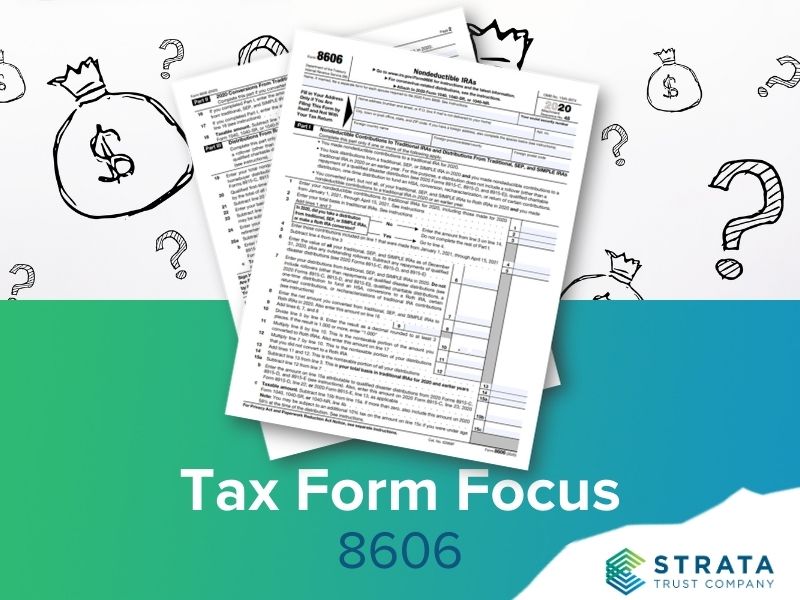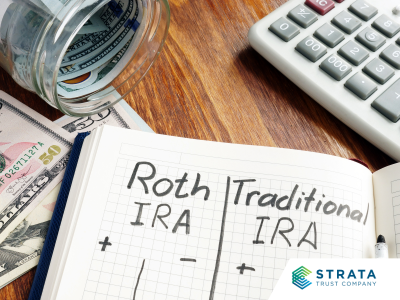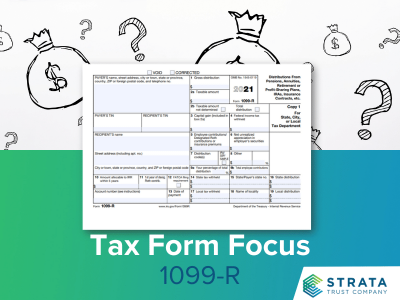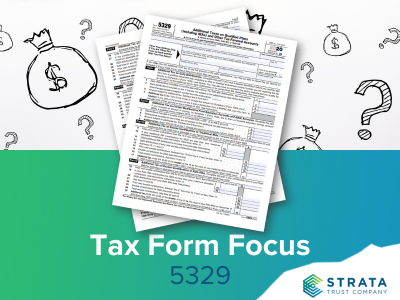As a self-directed IRA owner, you’ll want to monitor the tax forms related to your IRA investments to ensure you’re receiving the tax advantages available to you. Even if you engage a professional to prepare your tax returns or assist with your investment selection, understanding the information reported in these forms is important because they affect your tax liability for the year.
In this last installment of our 2020 Tax Form Focus series, we’ll focus on IRS Form 8606, Nondeductible IRAs. IRS Form 8606 is filed with your federal income tax return to track basis, or after-tax assets in your IRAs so you don’t pay tax twice on the same assets.
But First, A Refresher on IRA Taxation
Traditional, SEP and SIMPLE IRA distributions will be fully or partially taxable depending upon the types of contributions the IRA owner has made to their Traditional IRAs. If an IRA owner’s Traditional IRAs are funded solely with deductible annual contributions and rollovers of pre-tax assets from employer plans, any distribution from their Traditional, SEP, and SIMPLE IRA distributions will be taxable in the year of the distribution. A distribution may be only partially taxable if the IRA contains nondeductible contributions or rollovers of after-tax amounts. Each Traditional, SEP, and SIMPLE IRA distribution is considered a pro-rata return of basis, deductible contributions, and investment earnings. The portion of a distribution that represents basis is distributed tax-free. The IRS views all of an individual’s IRAs, except Roth IRAs, in aggregate when determining the taxable portion of a distribution.
A Roth IRA distribution will be fully or partially tax-free depending on whether the distribution is qualified. Qualified distributions are tax-free. If a Roth IRA distribution is not qualified, the earnings portion of the distribution will be taxable in the year of distribution. To determine the earnings portion of a distribution, IRA owners apply the Roth IRA ordering rules, which are different than the pro-rata formula that applies to Traditional IRAs. Roth IRA ordering rules provide that distributions are considered to come first from Roth contributions until that “bucket” is depleted, then from assets that have been converted or rolled from a pre-tax retirement account to the Roth. Only after all the tax-free basis and conversions have been removed are the taxable earnings considered distributed.
IRS Form 8606 Must Be Filed When You …
» Make a nondeductible contribution to your Traditional IRA – If you or your spouse participates in an employer’s retirement plan and your modified adjusted gross income exceeds the threshold to be eligible to deduct a Traditional IRA contribution, your IRA contribution for the year will be nondeductible. If a contribution is not tax-deductible, it is considered to have been made with money that has already been taxed. These contributions should not be taxed again when removed from the IRA, so they are tracked as basis. Basis is also made up of after-tax assets rolled into the IRA from an employer retirement plan and repayments of qualified disaster, reservist, and coronavirus-related distributions.
» Take a distribution from an IRA with basis – If you make nondeductible contributions or rollovers into a Traditional, SEP or SIMPLE IRA, you must file IRS Form 8606 when you take distribution to track the amount of basis included in each distribution. Recharacterizations and returns of excess contributions do not trigger the need for IRS Form 8606.
» Transfer Traditional, SEP or SIMPLE IRA assets to a spouse under a divorce decree – When IRA assets are split between former spouses in a divorce, any basis in the IRA must also be split. Both spouses must file IRS Form 8606 and show the increase or decrease in the amount of basis.
» Convert assets from a Traditional, SEP, or SIMPLE IRA to a Roth IRA – While IRS Form 8606 must be filed for an IRA-to-IRA conversion, it is not required when rolling over (converting) pre-tax assets from an employer-sponsored plan to a Roth IRA.
» Take a distribution from a Roth IRA – IRS Form 8606 is only required to be filed when you take nonqualified Roth IRA distributions (i.e., it is not filed for qualified distributions, rollovers, recharacterizations, or returns of excess contributions). Although IRS Form 8606 is used to track the amount of basis removed from a Roth IRA, it is not filed to report your after-tax contributions to a Roth IRA. You must look to past years’ IRS Form 5498 to track contributions.
» Take a distribution from an inherited IRA that has basis or take a nonqualified distribution from an inherited Roth IRA – If you inherit an IRA from a person who had a basis in the IRA, that basis remains with the IRA. Unless you are a spouse beneficiary and choose to treat the IRA as your own, you can’t combine this basis with any basis you have in your own IRAs or IRAs you inherited from other people. If you take distributions from both an inherited IRA and your IRA, and each has basis, you must complete separate IRS Forms 8606 to determine the taxable and nontaxable portions of those distributions.
Penalties Apply for Not Filing IRS Form 8606 Correctly
According to the Instructions for IRS Form 8606: “If you are required to file Form 8606 to report a nondeductible contribution to a traditional IRA for 2020, but don’t do so, you must pay a $50 penalty, unless you can show reasonable cause. If you overstate your nondeductible contributions, you must pay a $100 penalty, unless you can show reasonable cause.”
Seek tax advice if any of these situations apply to you to make certain you are accurately calculating the taxable assets for the current year and those remaining in your IRAs.










